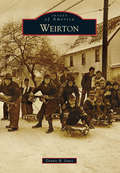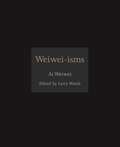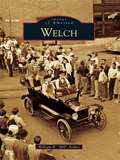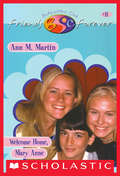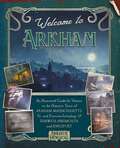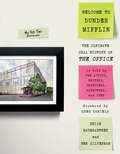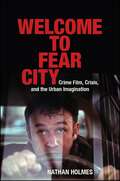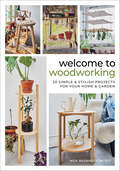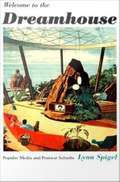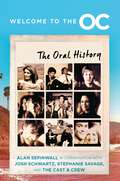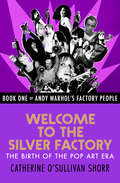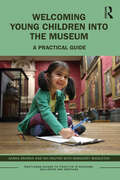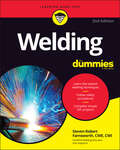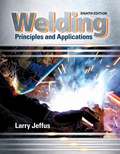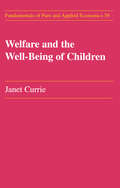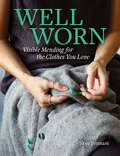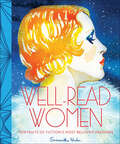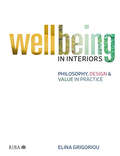- Table View
- List View
Weirton
by Dennis R. JonesWeirton was originally settled as the village of Holliday's Cove, a strategic fortification along the Ohio River in northwestern Virginia. In 1909, a tinplate mill was established in northern Holliday's Cove, and Weirton was born. Thousands of immigrants of many nationalities came here to work and live, while Ernest T. Weir created his life's dream of a fully integrated steel plant. Weirton became the "Largest Unincorporated Town in the Country" and remained unincorporated for 38 years. In 1947, Weirton combined with Holliday's Cove, Weirton Heights, and Marland Heights to become the official City of Weirton. Thomas E. Millsop, president of Weirton Steel Co., became the first mayor, and the mill became a major factor in the city's success. Many historic moments, including the record snowfall of Thanksgiving weekend 1950, were highlighted in the Weirton Steel Employees' Bulletin. Weirton captures this event and tells the story of the "New City," which thrived in the 1950s and 1960s.
Weiwei-isms (ISMs #1)
by Ai WeiweiThe quotable Ai WeiweiThis collection of quotes demonstrates the elegant simplicity of Ai Weiwei's thoughts on key aspects of his art, politics, and life. A master at communicating powerful ideas in astonishingly few words, Ai Weiwei is known for his innovative use of social media to disseminate his views. The short quotations presented here have been carefully selected from articles, tweets, and interviews given by this acclaimed Chinese artist and activist. The book is organized into six categories: freedom of expression; art and activism; government, power, and moral choices; the digital world; history, the historical moment, and the future; and personal reflections.Together, these quotes span some of the most revealing moments of Ai Weiwei's eventful career—from his risky investigation into student deaths in the 2008 Sichuan earthquake to his arbitrary arrest in 2011—providing a window into the mind of one of the world's most electrifying and courageous contemporary artists.Select Quotes from the Book:On Freedom of Expression"Say what you need to say plainly, and then take responsibility for it.""A small act is worth a million thoughts.""Liberty is about our rights to question everything."On Art and Activism"Everything is art. Everything is politics.""The art always wins. Anything can happen to me, but the art will stay.""Life is art. Art is life. I never separate it. I don't feel that much anger. I equally have a lot of joy."On Government, Power, and Making Moral Choice"Once you've tasted freedom, it stays in your heart and no one can take it. Then, you can be more powerful than a whole country.""I feel powerless all the time, but I regain my energy by making a very small difference that won't cost me much.""Tips on surviving the regime: Respect yourself and speak for others. Do one small thing every day to prove the existence of justice."On the Digital World"Only with the Internet can a peasant I have never met hear my voice and I can learn what's on his mind. A fairy tale has come true.""The Internet is uncontrollable. And if the Internet is uncontrollable, freedom will win. It's as simple as that.""The Internet is the best thing that could have happened to China."On History, the Historical Moment, and the Future"If a nation cannot face its past, it has no future.""We need to get out of the old language.""The world is a sphere, there is no East or West."Personal Reflection"I've never planned any part of my career—except being an artist. And I was pushed into that corner because I thought being an artist was the only way to have a little freedom.""Anyone fighting for freedom does not want to totally lose their freedom.""Expressing oneself is like a drug. I'm so addicted to it."
Welch
by William R. ArcherAfter the Civil War, Capt. Isaiah Welch, a Doddridge County, West Virginia, native, took a job as a surveyor with Maj. Jed Hotchkiss of Staunton, Virginia. Hotchkiss had served as Gen. Thomas "Stonewall" Jackson's mapmaker and charted Jackson's famous Valley Campaign, and Welch had been an officer of the 13th Battalion, Virginia Light Artillery. The war left Virginia's agrarian economy in ruins, and men like Hotchkiss and Welch worked to develop a new, industrial South. Welch surveyed the Pocahontas Coalfield in 1873, and a city named in his honor emerged in the heart of that great coalfield. Chartered on July 12, 1894, Welch has played a pivotal role in America's industrial revolution as a support system and supply house to the timber industry and as a coal industry hub. Throughout more than a century, Welch has served as a gateway for the raw materials and manpower that fueled the nation's quest for growth and power. The city has been constantly beset by the challenges of maintaining a civilization in West Virginia's steepest and most remote mountains, but after decades of being tested by nature, Welch is now on the verge of yet another renaissance.
Welcome Home, Mary Anne (The Baby-Sitters Club Friends Forever #11)
by Ann M. MartinMary Anne's been going through some big changes lately, but when a friend who's facing her own difficulties comes to stay for the summer, can Mary Anne help her cope?
Welcome Home: A Cozy Minimalist Guide to Decorating and Hosting All Year Round
by Myquillyn SmithDecorating for each season doesn't have to be overwhelming or expensive. Your home can be festive, stylish, and cozy with minimal effort and a limited budget--just ask The Nester! In Welcome Home, Myquillyn Smith guides you through creating and enjoying a seasonally decorated home with more style and less stuff.No matter what the world says, embracing the seasons does not require bins of factory-made décor or loads of time. In fact, it's possible to decorate for each season without frustration, going overboard, or blowing your budget.Drawing from the cozy-minimalist principles in Cozy Minimalist Home, stylist and Wall Street Journal bestselling author Myquillyn Smith will help you create a home that's fresh, meaningful, beautiful, and (bonus!) always ready to host. With engaging how-tos and inspiring photos, she guides you step by step through purposeful design decisions to cultivate a space where loved ones gather, meaningful connections are celebrated, and lasting memories are made.Myquillyn's realistic and down-to-earth design tips will teach you how to:Seasonalize your living spaces with simple, actionable stepsCultivate easy, seasonal rhythms of change in your homeIncorporate the beauty of the natural world through the five sensesFeel confident in volunteering your house for gatherings, parties, and impromptu get-togethersKnow what to focus on and what not to worry about as a relaxed and confident hostessBigger than the latest and greatest trends, Welcome Home aims to usher in the seasons without using more resources, money, or stuff than needed.
Welcome Mat
by Rosemary DrysdaleThe perfect finishing touch to the front door of any dollhouse, this mat measures 2 1/4 x 4 inches. This pattern was previously published in Miniature Crocheting and Knitting for Dollhouses (0-486-23964-0).
Welcome to Arkham: An Illustrated Guide for Visitors (Arkham Horror)
by David Annandale AP KloskyExplore the town of Arkham, setting for the beloved Arkham Horror series of tabletop games, in this comprehensive, full-color, hardcover guide to its people, places and strange goings on…Witness Arkham like you&’re walking its streets, peering into its shadows… It is the height of the Roaring Twenties. Flappers and young fellas dance the Charleston at raucous jazz clubs gleaming bright with electric lights. Beneath this gilded glamour, bloody turf wars rage, funded by gangsters and crooked cops who frequent rival speakeasies and gambling dens. Amid these changing times, old New England towns hold their secrets close. Off the Aylesbury pike, in reclusive Dunwich, rolling hills hide decrepit farms and witch-haunted hollows. Past Cape Ann, the remote fishing village of Innsmouth rots from within. At the mouth of the Miskatonic River, mist-shrouded Kingsport lies dreaming. All the while, historic Arkham broods on the upper banks of the Miskatonic, its famed university delving into the world&’s darkest, most ancient mysteries. Welcome to Arkham invites you to venture deeper than ever before into this legend-haunted city, inspired by H.P. Lovecraft&’s Cthulhu mythos and made famous by the Arkham Horror series of tabletop games. Welcome to Arkham is a complete guide to the city of Arkham and the neighboring towns of Dunwich, Innsmouth and Kingsport, detailing 115 fabled locations and featuring more than 500 illustrations. Walk the streets of Arkham, ride the Essex County Express, hitch a ride to Innsmouth (and pray you can find a way out), or take a ferry down the Miskatonic River, and read between the lines to discover what other mysteries lurk deeper still in the pages of this tattered old book… The definitive guide to the world of Arkham Horror.
Welcome to Dunder Mifflin: The Ultimate Oral History of The Office
by Ben Silverman Brian BaumgartnerJoin the entire Dunder Mifflin gang on a journey back to Scranton ... Based on hundreds of hours of exclusive interviews with the cast and creators and illustrated with 100 behind-the-scenes photographs, here, at last, is the untold inside story of The Office, featuring a foreword by Greg Daniels, who adapted the series for the U.S. and was its guiding creative force, and narrated by star Brian Baumgartner (aka “Kevin Malone”) and executive producer Ben Silverman. <p><p> Reuniting after nearly a decade, the entire Dunder Mifflin gang gathers again to share their favorite inside stories, spill untold secrets, and reveal how a little show that barely survived its first season became the most watched series in the universe. Welcome to Dunder Mifflin pulls back the curtain as never before on all the absurdity, genius, love, passion, and dumb luck that went into creating America's beloved The Office. <p><p> Featuring the memories of Steve Carell, John Krasinkski, Jenna Fischer, Greg Daniels, Ricky Gervais, Rainn Wilson, Angela Kinsey, Craig Robinson, Brian Baumgartner, Phyllis Smith, Kate Flannery, Ed Helms, Oscar Nunez, Amy Ryan, Ellie Kemper, Creed Bratton, Paul Lieberstein, Ben Silverman, Mike Schur, and many more.
Welcome to Fear City: Crime Film, Crisis, and the Urban Imagination (SUNY series, Horizons of Cinema)
by Nathan Holmes2019 CHOICE Outstanding Academic TitleThe early 1970s were a moment of transformation for both the American city and its cinema. As intensified suburbanization, racial division, deindustrialization, and decaying infrastructure cast the future of the city in doubt, detective films, blaxploitation, police procedurals, and heist films confronted spectators with contemporary scenes from urban streets. Welcome to Fear City argues that the location-shot crime films of the 1970s were part of a larger cultural ambivalence felt toward urban life, evident in popular magazines, architectural discourse, urban sociology, and visual culture. Yet they also helped to reinvigorate the city as a site of variegated experience and a positively disordered public life—in stark contrast to the socially homogenous and spatially ordered suburbs. Discussing the design of parking garages and street lighting, the dynamics of mugging, panoramas of ruin, and the optics of undercover police operations in such films as Klute, The French Connection, Detroit 9000, Death Wish, and The Taking of Pelham One Two Three, Nathan Holmes demonstrates that crime genres did not simply mirror urban settings and social realities, but actively produced and circulated new ideas about the shifting surfaces of public culture.
Welcome to Marwencol
by Chris Shellen Mark E. HogancampIn April 2000, Mark Hogancamp was beaten and left for dead outside a bar in his hometown of Kingston, NY. Waking from a nine-day coma, he had no memory of the thirty-eight prior years of his life, including his ex-wife, family, artistic talents, or military service. To reconstruct his past, Hogancamp built, in his backyard, Marwencol, an imaginary village set in World War II Belgium, where everybody is welcome--Germans, Americans, French, British, and Russians--as long as peace is kept. With 1:6 scale action figures and Barbie dolls, as well as toy armaments and meticulously built props, buildings, and clothes, Marwencol is an alternate reality, created with painstaking (and sometimes painful) realism and obsessive attention to detail.Here, riveting wartime dramas are played out and photographed in saturated hues and unflinching detail. The emotional narrative mirrors the artist's own: through Marwencol, Hogancamp regained his cognitive facilities.Welcome to Marwencol is an astonishing story of the redemptive power of art--of art as therapy and act of obsession.
Welcome to Pawnee: Stories of Friendship, Waffles, and Parks and Recreation
by Jim O'HeirJim O’Heir, who played Jerry (or Garry or Larry) on Parks and Recreation and co-hosts the hit podcast Parks and Recollection, brings fans a heartfelt behind-the-scenes look at one of America’s most beloved sitcoms, brimming with never-before-told stories featuring the cast and crew, along with dozens of unseen photos! For seven seasons, Leslie Knope and the Parks and Recreation gang charmed millions of viewers with their quirky antics and unwavering positivity. The sitcom continues to be a fan-favorite for streaming services today, nearly a decade after its finale. Now for the first time, Jim O’Heir, who played the lovable Jerry (or, well, Garry/Larry/Terry/Barry, depending on the episode), invites readers back to Pawnee for an exclusive look behind the scenes.Joined by some of his Parks and Rec pals, including Chris Pratt, Retta, Rob Lowe, and showrunners Greg Daniels and Mike Schur, O’Heir reveals how this “little show that could” came to be, thanks to the tireless dedication and comedic genius of Amy Poehler, Nick Offerman, and the rest of the gang. As the show found its footing, the cast quickly bonded into a tight-knit family. Here O’Heir shares all his favorite unforgettable memories both on and off camera, from hilarious unscripted moments and epic dance-offs in the hair and makeup trailers, to iconic birthday parties at Rashida Jones’s house and quiet bonfires in Nick Offerman’s backyard.Welcome to Pawnee is O’Heir’s loving tribute to Parks and Recreation, imbued with the same warmth and humor that endeared the show to millions.
Welcome to Woodworking: 20 Simple & Stylish Projects for Your Home & Garden
by Moa Brännström OttLearn the basic carpentry skills needed to furnish your home and garden with beautiful and useful wood items. Twenty accessible, step-by-step projects guide you through the essential techniques without large power tools. This book contains practical knowledge, including • how to choose good types of wood and the characteristics of the wood, • a tool review with an emphasis on hand tools, and • the methods used to measure, saw, plan, join, carve, and finish your wood creations. The projects feature clean, modern designs, including knife racks, cutting boards, shelves, stools, bookends, and benches. For those interested in gardening, there are flower tables, plant trellises, and more. The projects include easy-to-follow diagrams, and the levels of difficulty are adapted to readers who aren't used to working with wood, but who like its organic feel and expression. Explore the skills and techniques that make home carpentry a fun and rewarding craft.
Welcome to Your World: How the Built Environment Shapes Our Lives
by Sarah Williams GoldhagenOne of the nation’s chief architecture critics reveals how the environments we build profoundly shape our feelings, memories, and well-being, and argues that we must harness this knowledge to construct a world better suited to human experience.Taking us on a fascinating journey through some of the world’s best and worst landscapes, buildings, and cityscapes, Sarah Williams Goldhagen draws from recent research in cognitive neuroscience and psychology to demonstrate how people’s experiences of the places they build are central to their well-being, their physical health, their communal and social lives, and even their very sense of themselves. From this foundation, Goldhagen presents a powerful case that societies must use this knowledge to rethink what and how they build: the world needs better-designed, healthier environments that address the complex range of human individual and social needs.By 2050 America’s population is projected to increase by nearly seventy million people. This will necessitate a vast amount of new construction—almost all in urban areas—that will dramatically transform our existing landscapes, infrastructure, and urban areas. Going forward, we must do everything we can to prevent the construction of exhausting, overstimulating environments and enervating, understimulating ones. Buildings, landscapes, and cities must both contain and spark associations of natural light, greenery, and other ways of being in landscapes that humans have evolved to need and expect. Fancy exteriors and dramatic forms are never enough, and may not even be necessary; authentic textures and surfaces, and careful, well-executed construction details are just as important.Erudite, wise, lucidly written, and beautifully illustrated with more than one hundred color photographs, Welcome to Your World is a vital, eye-opening guide to the spaces we inhabit, physically and mentally, and a clarion call to design for human experience.
Welcome to the Dreamhouse: Popular Media and Postwar Suburbs
by Lynn SpigelIn Welcome to the Dreamhouse feminist media studies pioneer Lynn Spigel takes on Barbie collectors, African American media coverage of the early NASA space launches, and television's changing role in the family home and its links to the broader visual culture of modern art. Exploring postwar U. S. media in the context of the period's reigning ideals about home and family life, Spigel looks at a range of commercial objects and phenomena, from television and toys to comic books and magazines. The volume considers not only how the media portrayed suburban family life, but also how both middle-class ideals and a perceived division between private and public worlds helped to shape the visual forms, storytelling practices, and reception of postwar media and consumer culture. Spigel also explores those aspects of suburban culture that media typically render invisible. She looks at the often unspoken assumptions about class, nation, ethnicity, race, and sexual orientation that underscored both media images (like those of 1960s space missions) and social policies of the mass-produced suburb. Issues of memory and nostalgia are central in the final section as Spigel considers how contemporary girls use television reruns as a source for women's history and then analyzes the current nostalgia for baby boom era family ideals that runs through contemporary images of new household media technologies. Containing some of Spigel's well-known essays on television's cultural history as well as new essays on a range of topics dealing with popular visual culture, Welcome to the Dreamhouse is important reading for students and scholars of media and communications studies, popular culture, American studies, women's studies, and sociology.
Welcome to the Jungle: New Positions in Black Cultural Studies
by Kobena MercerWelcome to the Jungle brings a black British perspective to the critical reading of a wide range of cultural texts, events and experiences arising from volatile transformations in the politics of ethnicity, sexuality and "race" during the 1980s. The ten essays collected here examine new forms of cultural expression in black film, photography and visual art exerging with a new generation of black British artists, and interprets this prolific creativity within a sociological framework that reveals fresh perspectives on the bewildering complexity of identity and diversity in an era of postmodernity. Kobena Mercer documents a wealth of insights opened up by the overlapping of Asian, African and Caribbean cultures that constitute Black Britain as a unique domain of diaspora.
Welcome to the O.C.: The Oral History
by Alan Sepinwall Josh Schwartz Stephanie Savage“A fascinating peek behind the making of a megahit, and a delightful bit of nostalgia for those of us who remember life before streaming TV.” —Town & CountryWelcome to the O.C., b*tch: it’s the definitive oral history of beloved TV show The O.C., from the show’s creators, featuring interviews with the cast and crew, providing a behind-the-scenes look into how the show was made, the ups and downs over its four seasons, and its legacy today. On August 5th, 2003, Ryan Atwood found himself a long way from his home in Chino—he was in The O.C., an exclusive suburb full of beautiful girls, wealthy bullies, corrupt real-estate tycoons, and a new family helmed by his public defender, Sandy Cohen. Ryan soon warms up to his nerdy, indie band-loving new best friend Seth, and quickly falls for Marissa, the stunning girl next door who has secrets of her own. Completing the group is Summer, Seth’s dream girl and Marissa’s loyal—and fearless—best friend. Together, the friends fall in and out of love, support each other amidst family strife, and capture the hearts of audiences across the country.Just in time for the show’s twentieth anniversary, The O.C.’s creator Josh Schwartz and executive producer Stephanie Savage are ready to dive into how the show was made, the ups and downs over its four seasons, and its legacy today. With Rolling Stone’s chief TV critic and bestselling author Alan Sepinwall conducting interviews with the key cast members, writers, and producers who were there when it all happened, Welcome to the O.C. will offer the definitive inside look at the beloved show—a nostalgic delight for audiences who watched when it aired, and a rich companion to viewers currently discovering the show while it streams on HBO Max and Hulu.The O.C. paved the way for a new generation of iconic teen soaps, launched the careers of young stars, and even gave us the gift of Chrismukkah. Now, it’s time to go back where we started from and experience it all over again. Includes exclusive interviews with: Ben McKenzie * Mischa Barton * Adam Brody * Rachel Bilson * Peter Gallagher * Kelly Rowan * Melinda Clarke * Tate Donovan * Chris Carmack * Autumn Reeser * Willa Holland * Samaire Armstrong * Alan Dale * Colin Hanks * Amanda Righetti * Navi Rawat * Shannon Lucio * Michael Cassidy * McG * Imogen Heap * Alex Greenwald * Ben Gibbard * Paul Scheer * Doug Liman * and many more!
Welcome to the Silver Factory: The Birth of the Pop Art Era (Andy Warhol's Factory People #1)
by Catherine O'Sullivan ShorrThe 1st installment in a 3-part oral history, Welcome to the Silver Factory introduces the members of Andy Warhol's inner circle and their dazzling world of art, parties, drugs, and drama In the 1st volume of this fascinating oral history based on her documentary Andy Warhol's Factory People, Catherine O'Sullivan Shorr illuminates the early years of Andy Warhol's Factory scene through interviews with the artist's collaborators, close friends, and many associates who became superstars. Frustrated with advertising work, Warhol set up his legendary studio in 1962 in an abandoned hat factory on Manhattan's 47th Street. Rechristened and redecorated as the "Silver Factory," it quickly became the hub of Warhol's creative endeavors--the place where he constantly worked while an ever-changing cast of characters and muses passed through with their own contributions. Photos by the Factory's in-house photographer, Billy Name; candid interviews with Factory veterans like Ultra Violet, Mary Woronov, Taylor Mead, and Gerard Malanga; and discussions with chroniclers of the scene such as Victor Bockris and Henry Geldzahler provide revealing glimpses into life with Warhol. Working with silk-screen images of Marilyn Monroe, Campbell's soup cans, and Brillo boxes, Warhol pioneered Pop Art during the early 1960s, and O'Sullivan's assemblage of firsthand accounts expose the eccentric, elusive, and obsessive man behind the iconic art.
Welcoming Young Children into the Museum: A Practical Guide (Routledge Guides to Practice in Museums, Galleries and Heritage)
by Sarah Erdman Nhi Nguyen Margaret MiddletonWelcoming Young Children into the Museum provides all of the information practitioners need to consider when making the decision to engage with this audience and their carers. Meeting the reader where they are, this guide enables professionals to work toward outcomes that fit with their needs. Working methodically from the initial stages of bringing staff on board, through to implementation and evaluation, readers are carefully steered through each phase. "Big-picture" needs, like adherence to mission, are considered alongside logistical components, like cleaning schedules, to ensure that museums cater to young children in a way that is beneficial to both the visitors and the institution. Drawing on current neurological research and best practices in early childhood education and development, this guide presents case studies from a variety of different institutions around the world that demonstrate that creating interesting, developmentally appropriate opportunities for young children is about much more than just simplifying what is already on offer. Erdman, Nguyen and Middleton demonstrate that the age and needs of the visitors must be taken into careful consideration, as well as the assets and potential obstacles of the institution. Welcoming Young Children into the Museum will be essential reading for professionals working in museums large and small, regardless of type. It will be useful to those who are considering setting up new programmes for early years audiences and those with existing programmes, who would like to improve their offering.
Welding For Dummies
by Steven Robert FarnsworthEvery critical welding technique and process distilled into a one-stop, accessible resource Safe and effective welding might seem like a pipe dream if you’re just getting started. But with a little help from Welding For Dummies you’ll be a “golden arm” in no time. This guide will give you techniques you need to get a handle on material evaluation, clean-up, and every step in between. You’ll find practical advice on every popular kind of welding, including stick, tig, mig, fluxcore, and even oxyfuel cutting. You’ll also get tips on the ideal welding techniques to choose for specific projects. The book shows you how to: Find the required training for welding certifications Use brand-new welding technologies, including laser techniques Practice critical welding techniques you can use in your own hobby shop while staying safe Whether you’re looking for some help to further your do-it-yourself projects at home or you’re just getting started with a traditional welding educational program and you need a useful supplementary resource, Welding For Dummies is an irreplaceable reference that helps make a challenging trade accessible to everyone.
Welding Handbook Volume 3
by American Welding SocietyThis authoritative resource brings together 600 pages of comprehensive information on solid-state and other welding and cutting processes. The book includes chapters on the following welding processes: resistance spot and seam, projection, flash and upset, and high-frequency. The final chapter covers various other welding and cutting processes, including modernized water jet cutting. Written, updated, and peer reviewed by a group of highly respected technical and scientific experts.•Provides a comprehensive chapter on resistance welding equipment, with photos of state-of-the-art equipment and accompanied by new electrical diagrams and drawings.• In addition to a chapter on friction welding, a new chapter introduces friction stir welding, the process that has users excited about its significant advantages.• Discusses the most recent developments in beam technology in greatly expanded chapters on laser beam welding and cutting and electron beam welding.• Presents a diverse array of processes in chapters on ultrasonic welding, explosion welding, diffusion welding and diffusion brazing, adhesive bonding, and thermal and cold spraying.• Also discusses various other welding and cutting processes, including sections on two emerging processes: magnetic pulse welding and electro-spark deposition, plus the return of water jet cutting as a modern process.• Includes a section on safe practices specific to the process in each chapter. This volume is devoted to information on resistance welding, solid state processes, and other joining and cutting methods. It contains updated resistance welding chapters: spot and seam welding, projection welding, flash and upset welding, high-frequency welding, and resistance welding equipment. The chapter on friction welding been updated. New in this edition is a separate chapter on the developing process variation of friction stir welding. Other chapters explore ultrasonic welding, explosion welding, adhesive bonding, thermal spraying and cold spraying, diffusion welding, and diffusion brazing. The chapters on electron beam welding and laser beam welding and cutting contain significantly expanded technology. The last chapter, Other Welding and Cutting Processes, contains information on two new or revitalized processes, magnetic pulse welding, and electro-spark depositing. New information is presented on water jet cutting, which is reappearing in many current applications as a modern, efficient process.
Welding: Principles And Applications (Eighth Edition)
by Larry JeffusThis proven guide provides the knowledge and skills you need to complete AWS SENSE Level I and Level II programs, create Workmanship Qualification Specimens, and earn professional certification. Advancing rapidly from basic concepts and processes to today's most complex, cutting-edge welding technologies and practices, this comprehensive text features valuable information on topics such as welding metallurgy, metal fabrication, weld testing and inspection, joint design, job costing, and environmental and conservation tips. The author opens each section by introducing you to the materials, equipment, setup procedures, and critical safety information you need to execute a specific process successfully, while subsequent chapters focus on individual welding tasks leading to SENSE certification. Now with MindTap for Welding, complete with simulation and up-to-date welding videos.
Welfare and the Well-Being of Children
by Janet M. CurrieAn analysis of eight of the largest US welfare programmes affecting children. These programmes include Aid to Families with Dependent Children, the Food Stamp Program. Medicaid, housing assistance, supplemental feeding programmes such as WIC and School Lunch, Head Start and the Earned Income Tax Credit. Despite the fact that these programmes were designed to serve children, most discussion of welfare reforms focuses on the incentives that the welfare system creates for parents. This analysis represents an evaluation of the evidence regarding the effects of welfare programmes on the children themselves. Programmes such as Medicaid and Head Start have a larger effect on measures of child well-being than cash transfer programs such as AFDC. This suggests an economic rationale for the recent trend towards providing a larger proportion of assistance in-kind.
Well Worn: Visible Mending for the Clothes You Love
by Skye PennantMend and revive your favorite well-worn garments with this comprehensive guide to visible mending techniques from the founder of Slow Stitch Club.From the creator of the popular Slow Stitch Club, Well Worn is a fresh and engaging clothing repair guide and accessible introduction for anyone looking to explore visible mending to revolutionize their wardrobe, whether you are a stitching pro or have never picked up a needle and thread.Mending is a creative outlet and a slow and therapeutic skill, and author and textile artist Skye Pennant shares the joys of mending by teaching traditional darning and sashiko techniques to help fight against wardrobe perfectionism as well as fast fashion, making for gorgeous visible mending results. Her introduction includes a short history of mending followed by key techniques, fabrics, tools, and materials. Sections are organized by type of clothing to mend: Jeans & Denim, Sweaters & Knitwear, T-Shirts, Socks, and more.An outstanding gift or self-purchase for anyone interested in refreshing their wardrobe, fostering a more sustainable lifestyle, saving money and avoiding fast fashion, or simply engaging with a crafty new creative outlet, this sewing basics book is all about mending clothes you love, one slow stitch at a time.
Well-Read Women: Portraits of Fiction's Most Beloved Heroines
by Samantha Hahn“They’re all here—Clarissa Dalloway, Dorothea Brooke, Nancy Drew—and each one is drawn so magnificently that their authors would rejoice as we rejoice.” —Emma Straub, New York Times bestselling author A treasure of a gift for the well-read woman, this collection brings together fifty stirring portraits, in watercolor and in word, of literature’s most well-read female characters. Anna Karenina, Clarissa Dalloway, Daisy Buchanan . . . each seems to live on the page through celebrated artist Samantha Hahn’s evocative portraits and hand-lettered quotations, with the pairing of art and text capturing all the spirit of the character as she was originally written. The book itself evokes vintage grace reimagined for contemporary taste. In the hand and in the reading, here is a new classic for the book lover’s library.“These women are important. They illuminate the world. So read, read, read their words. And learn what life is.” —Maira Kalman, bestselling author and illustrator of Beloved Dog“Richly illustrated and exquisitely hand-lettered, Well-Read Women is the perfect convergence of literature and art—and a wonderful gift for any passionate reader. I have devoured it already several times over.” —Lisa Congdon, artist and author of Find Your Artistic Voice“Samantha Hahn’s exuberant watercolors paired with sharply chosen quotes feel at once nostalgic and modern, stylish and genuine. All qualities befitting the complex women she renders.” —Stella Bugbee, Styles Editor, TheNew YorkTimes“The perfect collection of our favorite fictional heroines brought to life in gorgeous illustrations by the immensely talented Samantha Hahn—it’s destined to become a classic and inspire readers and artists alike.” —Christiane Lemieux, founder/CEO, The Inside, and author of Undecorate
Wellbeing in Interiors: Philosophy, Design and Value in Practice
by Richard Francis Elina GrigoriouThis 4-colour practical guide explores how the design of interior spaces impacts wellbeing. In the built environment, this topic is generally overlooked, even though it is one of the most important topics in sustainable building. This book will enable project teams to understand how specific decisions about sustainable design and materials can be implemented on a day to day basis. Each Part ends by placing each issue into context, exploring how it is a part of sustainable design and includes practical examples. This books raises awareness of the impact interior environments have on wellbeing, and provide details and guidance on how to immediately apply the knowledge in this book to short and long term projects. It also quantifies the impacts in financial and other value terms, making this book immediately useful in a designer's day-to-day work.
